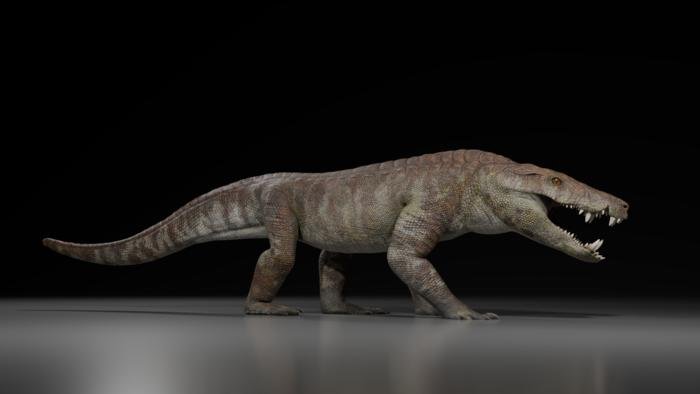Meet Kostensuchus atrox: a 3.5-meter crocodile-relative from Patagonia
A well-preserved fossil of a newly discovered species of large, crocodile-like predator is described in a new study, “A new large hypercarnivorous crocodyliform from the Maastrichtian of Southern Patagonia, Argentina,” published in PLOS One.
The skull, wide jaws, and other bones were discovered in the Chorrillo Formation, a rock formed about 70 million years ago in southern Patagonia. At that time, dinosaurs, tortoises, and various mammals inhabited this area. The fossil is very well preserved, mostly intact. As scientists explained, this crocodile-like predator could reach a length of about 3.5 meters and a weight of about 250 kilograms. With its large teeth, it could probably devour large prey, including medium-sized dinosaurs.
The species has been named Kostensuchus atrox, referring to the Patagonian wind known in the native Tehuelche language as Kosten and the crocodile-headed Egyptian god known as Souchos, where atrox means “fierce” or “sharp.” It should be noted that this is not a dinosaur, but a peirosaurid crocodyliform, an extinct group of reptiles related to modern crocodiles and alligators. The researchers believe it was likely one of the top predators in the region, and it is also the first well-preserved crocodyliform fossil found in this formation.
Argentinian paleontologist Fernando Novas of the Comparative Anatomy Department at the Bernardino Rivadavia Natural Sciences Museum in Buenos Aires, Argentina, and author of the study for Unknown Focus, described his day in the field and shared his first thoughts upon seeing the study’s results.
When you first saw the study’s results, what was the first thing that came to mind?
Fernando Novas: I realized that meat-eating dinosaurs that roamed southern Patagonia 70 million years ago were not alone among top predators, but they had to compete with this bulky, three-meter-long crocodyliform. The massive construction of its head and the line of large and sharp teeth in its jaws made Kostensuchus atrox a fierce animal capable of preying upon medium-sized plant-eating dinosaurs and defending its prey items from the attack of a large megaraptoran.
“For me, a day in the field is a day of impatience.”
We get such exciting discoveries, but I’m curious, what does a day in the field look like for you, and how long does it usually last?
Fernando Novas: For me, a day in the field is a day of impatience. I pray for a discovery that any member of the crew can make. We might find a bone or a single tooth at the beginning and start a dig, anxious to find more remains of that creature. A dig doesn’t always yield what one hopes for, but, fortunately, with a mixture of luck, hard work, and perseverance, my team and I produced remarkable discoveries in different regions of Argentina. Also, no less important, are the next two main steps in our labors: conduct the best possible technical preparation of the fossils (thus recovering detailed and novel anatomical information), and then publish interpretations about the evolution, phylogenetic relationships, and paleobiogeographic history of such discoveries, with the eyes of a South American researcher. We aim to have a better idea about the connections between the dinosaurs and other animals that lived in Patagonia with those that inhabited other regions of the planet.
“The fossil locality in which we discovered Kostensuchus atrox also yielded a wide array of organisms, from tiny insects and plants to the bones of huge dinosaurs. “
What do you particularly like about this study, and what new things can it tell us about Patagonia?
Fernando Novas: The fossil locality in which we discovered Kostensuchus atrox also yielded a wide array of organisms, from tiny insects and plants to the bones of huge dinosaurs. The site is very rich, and it produced a single, but really revolutionary, tooth of a monotreme: a Cretaceous ancestor of the living platypus that lives today in Australia. This prehistoric treasure has two qualities: it is 70 million years old, and it offers information on the environmental and ecological conditions that prevailed shortly before the catastrophe that ended dinosaur dominance. It was geographically located at the southern tip of South America; thus, “with a jump,” at least some of the organisms mentioned above may have dispersed through Antarctica and Australia. By working down there, in southern Argentina, I feel we are opening the door to a vanished world that may reveal the causes that provoked dinosaur extinction, as well as the beginning of a new era composed of organisms quite different from those that evolved in the northern landmasses.
Image: Kostensuchus atrox – life restauration, 3 meters long. Art by Gabriel Diaz Yanten


